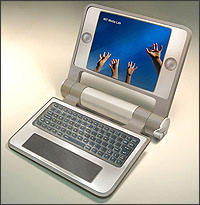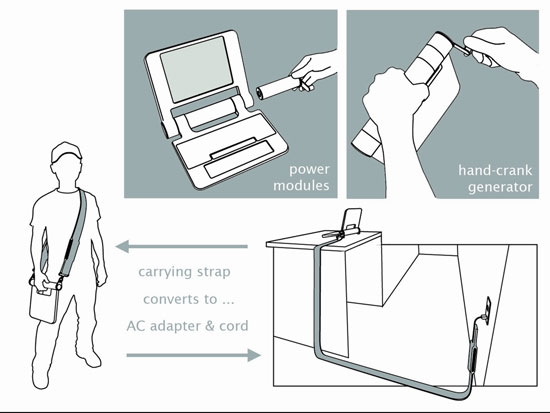The Times comes out once again in support of network neutrality, with hopes that the soon to be Democrat-controlled Congress will make decisive progress on that front in the coming year.
Meanwhile in a recent Wired column, Larry Lessig, also strongly in favor of net neutrality but at the same time hesitant about the robust government regulation it entails, does a bit of soul-searching about the landmark antitrust suit brought against Microsoft almost ten years ago. Then too he came down on the side of the regulators, but reflecting on it now he says might have counseled differently had he known about the potential of open source (i.e. Linux) to rival the corporate goliath. He worries that a decade from now he may arrive at similar regrets when alternative network strategies like community or municipal broadband may by then have emerged as credible competition to the telecoms and telcos. Still, seeing at present no “Linus Torvalds of broadband,” he decides to stick with regulation.
Network neutrality shouldn’t be trumpeted uncritically, and it’s healthy and right for leading advocates like Lessig to air their concerns. But I think he goes too far in saying he was flat-out wrong about Microsoft in the late 90s. Even with the remarkable success of Linux, Microsoft’s hegemony across personal and office desktops seems more or less unshaken a decade after the DOJ intervened.
Allow me to add another wrinkle. What probably poses a far greater threat to Microsoft than Linux is the prospect of a web-based operating system of the kind that Google is becoming, a development that can only be hastened by the preservation of net neutrality since it lets Google continue to claim an outsized portion of last-mile bandwidth at a bargain rate, allowing them to grow and prosper all the more rapidly. What seems like an obvious good to most reasonable people might end up opening the door wider for the next Microsoft. This is not an argument against net neutrality, simply a consideration of the complexity of getting what we wish and fight for. Even if we win, there will be other fights ahead. United States vs. Google?
Category Archives: linux
a chink in the armor of open source?
With the coming release of Sophie and our recent attendence at the Access 2 Knowledge conference, I find myself thinking about open source software development. The operating system Linux is often used as the shining example of the open source software movement. Slashdot reported an interesting ZDNet UK article, which quoted the head maintainer of the Linux production kernal, Andrew Morton, saying that he is concerned about the large number of long standing bugs in the 2.6 kernal. Software always has bugs being worked out, even the long standing ones that Morton describes. Therefore, the statement is not all that shocking or surprising.
What intrigued me was this following statement:
“One problem is that few developers are motivated to work on bugs, according to Morton. This is particularly a problem for bugs that affect old computers or peripherals, as kernel developers working for corporations don’t tend to care about out-of-date hardware, he said. Nowadays, many kernel developers are employed by IT companies, such as hardware manufacturers, which can cause problems as they can mainly be motivated by self-interest.
“If you’re a company that employs a kernel maintainer, you don’t have an interest in working on a five-year-old peripheral that no one is selling any more. I can understand that, but it is a problem as people are still using that hardware. The presence of that bug affects the whole kernel process, and can hold up the kernel — as there are bugs, but no one is fixing them,” said Morton.
Keeping contributors motivated is crucial to open source endeavors. Reputation is a major factor in what drives people to submit code to the Linux development team. In retrospect, the importance of adding code for new features over adding mundane code for bug fixes, as part of reputation building makes sense. The street cred for fixing old bugs does not seem to be sexy enough; eventhough, some of these bugs could have long term effects on the quality of the Linux OS.
Are there solutions? One solution posited by Morton is to dedicate the entire next release to fixing long standing bugs. Although it is not clear to me how open source developers would react to this constraint. Another solution might try to expand the talent pool by encouraging young, gifted (even student) programmers to work on the bugs. Their motivations might be different from current developers, and any kind of participation might offer enough motivation.
Open source software development is still a fairly new phenomenon and is far from being completely understood. As we see more clearly how motivation factors work and what they produce in the open source production model, it will be increasingly important to document, analyze and learn from these observations. The future sustainability for open source software will rely on learning how to best maintain the developers’ incentives to contribute code. Therefore, we must remind ourselves that the open source development movement is something that must be continuously nurtured. And while we can cite Linux as a success story, the project itself is not on autopilot, nor will it ever be.
flushing the net down the tubes
Grand theories about upheavals on the internet horizon are in ready supply. Singularities are near. Explosions can be expected in the next six to eight months. Or the whole thing might just get “flushed” down the tubes. This last scenario is described at length in a recent essay in Linux Journal by Doc Searls, which predicts the imminent hijacking of the net by phone and cable companies who will turn it into a top-down, one-way broadcast medium. In other words, the net’s utopian moment, the “read/write” web, may be about to end. Reading Searls’ piece, I couldn’t help thinking about the story of radio and a wonderful essay Brecht wrote on the subject in 1932:

Here is a positive suggestion: change this apparatus over from distribution to communication. The radio would be the finest possible communication apparatus in public life, a vast network of pipes. That is to say, it would be if it knew how to receive as well as to transmit, how to let the listener speak as well as hear, how to bring him into a relationship instead of isolating him. On this principle the radio should step out of the supply business and organize its listeners as suppliers….turning the audience not only into pupils but into teachers.
Unless you’re the military, law enforcement, or a short-wave hobbyist, two-way radio never happened. On the mainstream commercial front, radio has always been about broadcast: a one-way funnel. The big FM tower to the many receivers, “prettifying public life,” as Brecht puts it. Radio as an agitation? As an invitation to a debate, rousing families from the dinner table into a critical encounter with their world? Well, that would have been neat.
Now there’s the internet, a two-way, every-which-way medium — a stage of stages — that would have positively staggered a provocateur like Brecht. But although the net may be a virtual place, it’s built on some pretty actual stuff. Copper wire, fiber optic cable, trunks, routers, packets — “the vast network of pipes.” The pipes are owned by the phone and cable companies — the broadband providers — and these guys expect a big return (far bigger than they’re getting now) on the billions they’ve invested in laying down the plumbing. Searls:
The choke points are in the pipes, the permission is coming from the lawmakers and regulators, and the choking will be done….The carriers are going to lobby for the laws and regulations they need, and they’re going to do the deals they need to do. The new system will be theirs, not ours….The new carrier-based Net will work in the same asymmetrical few-to-many, top-down pyramidal way made familiar by TV, radio, newspapers, books, magazines and other Industrial Age media now being sucked into Information Age pipes. Movement still will go from producers to consumers, just like it always did.
If Brecht were around today I’m sure he would have already written (or blogged) to this effect, no doubt reciting the sad fate of radio as a cautionary tale. Watch the pipes, he would say. If companies talk about “broad” as in “broadband,” make sure they’re talking about both ends of the pipe. The way broadband works today, the pipe running into your house dwarfs the one running out. That means more download and less upload, and it’s paving the way for a content delivery platform every bit as powerful as cable on an infinitely broader band. Data storage, domain hosting — anything you put up there — will be increasingly costly, though there will likely remain plenty of chat space and web mail provided for free, anything that allows consumers to fire their enthusiasm for commodities through the synapse chain.
 If the net goes the way of radio, that will be the difference (allow me to indulge in a little dystopia). Imagine a classic Philco cathedral radio but with a few little funnel-ended hoses extending from the side that connect you to other listeners. “Tune into this frequency!” “You gotta hear this!” You whisper recommendations through the tube. It’s sending a link. Viral marketing. Yes, the net will remain two-way to the extent that it helps fuel the market. Web browsers, like the old Philco, would essentially be receivers, enabling participation only to the extent that it encouraged others to receive.
If the net goes the way of radio, that will be the difference (allow me to indulge in a little dystopia). Imagine a classic Philco cathedral radio but with a few little funnel-ended hoses extending from the side that connect you to other listeners. “Tune into this frequency!” “You gotta hear this!” You whisper recommendations through the tube. It’s sending a link. Viral marketing. Yes, the net will remain two-way to the extent that it helps fuel the market. Web browsers, like the old Philco, would essentially be receivers, enabling participation only to the extent that it encouraged others to receive.
You might even get your blog hosted for free if you promote products — a sports shoe with gelatinous heels or a music video that allows you to undress the dancing girls with your mouse. Throw in some political rants in between to blow off some steam, no problem. That’s entrepreneurial consumerism. Make a living out of your appetites and your ability to make them infectious. Hip recommenders can build a cosy little livelihood out of their endorsements. But any non-consumer activity will be more like amateur short-wave radio: a mildly eccentric (and expensive) hobby (and they’ll even make a saccharine movie about a guy communing with his dead firefighter dad through a ghost blog).
Searls sees it as above all a war of language and metaphor. The phone and cable companies will dominate as long as the internet is understood fundamentally as a network of pipes, a kind of information transport system. This places the carriers at the top of the hierarchy — the highway authority setting the rules of the road and collecting the tolls. So far the carriers have managed, through various regulatory wrangling and court rulings, to ensure that the “transport metaphor” has prevailed.
But obviously the net is much more than the sum of its pipes. It’s a public square. It’s a community center. It’s a market. And it’s the biggest publishing system the world has ever known. Searls wants to promote “place metaphors” like these. Sure, unless you’re a lobbyist for Verizon or SBC, you probably already think of it this way. But in the end it’s the lobbyists that will make all the difference. Unless, that is, an enlightened citizens’ lobby begins making some noise. So a broad, broad as in broadband, public conversation should be in order. Far broader than what goes on in the usual progressive online feedback loops — the Linux and open source communities, the creative commies, and the techno-hip blogosphere, that I’m sure are already in agreement about this.
Google also seems to have an eye on the pipes, reportedly having bought thousands of miles of “dark fiber” — pipe that has been laid but is not yet in use. Some predict a nationwide “Googlenet.” But this can of worms is best saved for another post.
no laptop left behind
 MIT has re-dubbed its $100 Laptop Project “One Laptop Per Child.” It’s probably a good sign that they’ve gotten children into the picture, but like many a program with sunny-sounding names and lofty goals, it may actually contain something less sweet. The hundred-dollar laptop is about bringing affordable computer technology to the developing world. But the focus so far has been almost entirely on the hardware, the packaging. Presumably what will fit into this fancy packaging is educational software, electronic textbooks and the like. But we aren’t hearing a whole lot about this. Nor are we hearing much about how teachers with little or no experience with computers will be able to make use of this powerful new tool.
MIT has re-dubbed its $100 Laptop Project “One Laptop Per Child.” It’s probably a good sign that they’ve gotten children into the picture, but like many a program with sunny-sounding names and lofty goals, it may actually contain something less sweet. The hundred-dollar laptop is about bringing affordable computer technology to the developing world. But the focus so far has been almost entirely on the hardware, the packaging. Presumably what will fit into this fancy packaging is educational software, electronic textbooks and the like. But we aren’t hearing a whole lot about this. Nor are we hearing much about how teachers with little or no experience with computers will be able to make use of this powerful new tool.
The headlines tell of a revolution in the making: “Crank It Up: Design of $100 Laptop for the World’s Children Unveiled” or “Argentina Joins MIT’s Low-Cost Laptop Plan: Ministry of Education is ordering between 500,000 to 1 million.” Conspicuously absent are headlines like “Web-Based Curriculum in Development For Hundred Dollar Laptops” or “Argentine Teachers Go On Tech Tutorial Retreats, Discuss Pros and Cons of Technology in the Classroom.”

Help! Help! We’re sinking!
This emphasis on the package, on the shell, makes me think of the Container Store. Anyone who has ever shopped at the Container Store knows that it is devoted entirely to empty things. Shelves, bins, baskets, boxes, jars, tubs, and crates. Empty vessels to organize and contain all the bric-a-brac, the creeping piles of crap that we accumulate in our lives. Shopping there is a weirdly existential affair. Passing through aisles of hollow objects, your mind filling them with uses, needs, pressing abundances. The store’s slogan “contain yourself” speaks volumes about a culture in the advanced stages of consumption-induced distress. The whole store is a cry for help! Or maybe a sedative. There’s no question that the Container Store sells useful things, providing solutions to a problem we undoubtedly have. But that’s just the point. We had to create the problem first.
I worry that One Laptop Per Child is providing a solution where there isn’t a problem. Open up the Container Store in Malawi and people there would scratch their heads. Who has so much crap that they need an entire superstore devoted to selling containers? Of course, there is no shortage of problems in these parts of the world. One need not bother listing them. But the hundred-dollar laptop won’t seek to solve these problems directly. It’s focused instead on a much grander (and vaguer) challenge: to bridge the “digital divide.” The digital divide — that catch-all bogey, the defeat of which would solve every problem in its wake. But beware of cure-all tonics. Beware of hucksters pulling into the dusty frontier town with a shiny new box promising to end all woe.
A more devastating analogy was recently drawn between MIT’s hundred dollar laptops and pharmaceutical companies peddling baby formula to the developing world, a move that has made the industries billions while spreading malnutrition and starvation.
Breastfeeding not only provides nutrition, but also provides immunity to the babies. Of course, for a baby whose mother cannot produce milk, formula is better than starvation. But often the mothers stop producing milk only after getting started on formula. The initial amount is given free to the mothers in the poor parts of the world and they are told that formula is much much better than breast milk. So when the free amount is over and the mother is no longer lactating, the formula has to be bought. Since it is expensive, soon the formula is severely diluted until the infant is receiving practically no nutrition and is slowly starving to death.
…Babies are important when it comes to profits for the peddlers of formula. But there are only so many babies in the developed world. For real profit, they have to tap into the babies of the under-developed world. All with the best of intentions, of course: to help the babies of the poor parts of the world because there is a “formula divide.” Why should only the rich “gain” from the wonderful benefits of baby formula?
Which brings us back to laptops:
Hundreds of millions of dollars which could have been more useful in providing primary education would instead end up in the pockets of hardware manufacturers and software giants. Sure a few children will become computer-savvy, but the cost of this will be borne by the millions of children who will suffer from a lack of education.
Ethan Zuckerman, a passionate advocate for bringing technology to the margins, was recently able to corner hundred-dollar laptop project director Nicholas Negroponte for a couple of hours and got some details on what is going on. He talks at great length here about the design of the laptop itself, from the monitor to the hand crank to the rubber gasket rim, and further down he touches briefly on some of the software being developed for it, including Alan Kay’s Squeak environment, which allows children to build their own electronic toys and games.
The open source movement is behind One Laptop Per Child in a big way, and with them comes the belief that if you give the kids tools, they will teach themselves and grope their way to success. It’s a lovely thought, and may prove true in some instances. But nothing can substitute for a good teacher. Or a good text. It’s easy to think dreamy thoughts about technology emptied of content — ready, like those aisles of containers, drawers and crates, to be filled with our hopes and anxieties, to be filled with little brown hands reaching for the stars. But that’s too easy. And more than a little dangerous.
Dropping cheap, well-designed laptops into disadvantaged classrooms around the world may make a lot of money for the manufacturers and earn brownie points for governments. And it’s a great feel-good story for everyone in the thousand-dollar laptop West. But it could make a mess on the ground.
this laptop costs $100

MIT has released some new images of its $100 laptop prototype, of which it hopes to have 5 to 15 million test units within the year. The laptops are much more durable than your average commercial machine, can be used as writing tablets or rotated 90 degrees as ebooks, and run on Linux – 100% free software. The idea is for the machines to provide a platform for an open source education movement throughout the South – a major hack of the current global order.
I love the hand cranks on the side, a backup charging option for remote or poorly provided areas where there is little or no electricity.
(“The $100 laptop moves closer to reality” in CNET)

